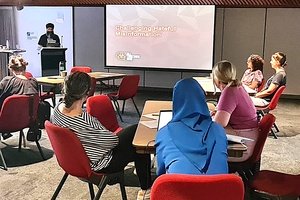It’s hotly contested space. But too often in these cyclical debates, what really happens in the classroom gets missed.
Good classroom practice addresses what’s in the curriculum but involves much more. Teachers are constantly making decisions on how to deliver curriculum, what to skim quickly, what to combine, what to emphasise, depending on their students’ needs.
It’s what we call the enacted curriculum, what actually happens in the classroom.
Yes, teachers deliver the curriculum, but it works in tandem with how they teach and assess. These three pillars of schooling – curriculum, pedagogy and assessment – all need to be considered in a high achieving education system.
All three ultimately shape students’ learning experiences. Supporting teachers as they do this critical work is what’s required. This is all the more important as we emerge from the pandemic.
Too often in education, debates about what’s best for students pitch one idea, teaching strategy, or curriculum agenda against another. These debates convey simplistic ideological battles (on both progressive and conservative sides of politics) when the realities of teaching are far more complex.
The national curriculum is always contested space, a battle of values. We see whole language pitched against phonics teaching, we see fundamental maths skills pitched against problem solving, we see Western Civilisation pitched against First Nations history and culture. As if we don’t need both.
When it comes to approaches to teaching, explicit instruction is pitted against inquiry, teacher directed against student centred, memorisation versus guided discovery.
Depending on the context, the lesson, the needs of the students, all these teaching approaches can be valid and impactful. They are complementary rather than competing.
What’s most important to ensuring learning is the quality of teaching delivered.
Nearly 20 years ago Associate Professor James Ladwig and I developed the Quality Teaching Model for the NSW Department of Education. The model distils the essence of quality teaching with 18 evidence-based elements across three main areas: intellectual quality or promoting deep understanding of important ideas; a quality learning environment filled with high and explicit expectations and appropriate support; and significance to help students connect their learning to the world beyond the classroom.
It is widely accepted that the quality of teaching is the most significant in-school factor affecting academic achievement. To improve the quality of teaching, we need an agreed conceptual framework and deep understanding of what quality teaching means.
Pitching teaching approaches (or curricula) against each other in a way that suggests we must have only one or the other is unhelpful, and ultimately misses what really happens in the classroom.
If we want to create well rounded human beings, and citizens, students need to have good knowledge foundations and problem solving skills. Treating these learning goals as in opposition to each other is counterproductive.
We want students to have a positive experience of learning and to leave school thoughtful and informed. Improving the quality of teaching in ways that respect the work of teachers and honour its complexity is key to lifting student outcomes.














